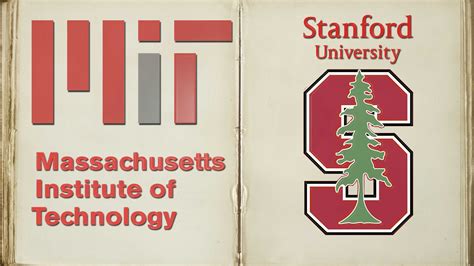Introduction
In the realm of higher education, the rivalry between Stanford University and the Massachusetts Institute of Technology (MIT) has captured the imagination of aspiring engineers, scientists, and innovators for decades. Both institutions are renowned for their academic excellence, cutting-edge research, and prestigious alumni. But what truly sets them apart? This article delves into the intricacies of the Stanford vs. MIT rivalry, exploring their similarities, differences, and the unique strengths and weaknesses that make them true tech titans.

Academic Programs
Stanford and MIT offer a vast array of undergraduate and graduate programs in engineering, computer science, and related fields. Stanford boasts a slightly larger student body with over 7,000 undergraduate and 10,000 graduate students, while MIT enrolls approximately 4,500 undergraduates and 7,000 graduate students.
Undergraduate Programs
- Stanford: Stanford’s undergraduate engineering program is known for its flexibility and interdisciplinary approach. Students can choose from a wide range of majors, including Bioengineering, Computer Science, and Materials Science.
- MIT: MIT’s undergraduate engineering program is highly structured and focuses on developing strong analytical and problem-solving skills. Students specialize in areas such as Chemical Engineering, Electrical Engineering, and Mechanical Engineering.
Graduate Programs
- Stanford: Stanford’s graduate programs in engineering, computer science, and the social sciences are highly competitive and attract top students from around the world. The university’s research-intensive environment fosters innovative thinking and cutting-edge research.
- MIT: MIT’s graduate programs in engineering, computer science, and business are equally prestigious and selective. The university’s close ties to industry provide students with unparalleled opportunities for research and practical experience.
Research and Innovation
Both Stanford and MIT are at the forefront of scientific and technological advancements. They consistently rank among the top universities in the world for research and development expenditures.
- Research Funding: In 2022, Stanford received over $1.8 billion in research funding from government agencies, corporations, and foundations, while MIT received over $1.2 billion.
- Patents: Stanford and MIT generate a significant number of patents annually, reflecting the innovative nature of their research. In 2021, Stanford was granted over 400 patents, while MIT received over 300.
Notable Alumni and Impact
Stanford and MIT have produced an impressive roster of notable alumni who have made significant contributions to science, technology, and business.
- Stanford: Notable alumni include Google co-founder Sergey Brin, Tesla CEO Elon Musk, and former U.S. President Herbert Hoover.
- MIT: Notable alumni include Amazon founder Jeff Bezos, Wikipedia founder Jimmy Wales, and Nobel Prize-winning physicist Richard Feynman.
Culture and Campus Life
Despite their shared focus on science and technology, Stanford and MIT have distinct campus cultures.
- Stanford: Stanford’s campus is located in the heart of Silicon Valley and has a vibrant entrepreneurial spirit. The university encourages students to pursue their passions outside of the classroom, with a strong emphasis on interdisciplinary collaboration.
- MIT: MIT’s campus is situated in Boston’s Kendall Square, a hub for innovation and technology. The university fosters a culture of intellectual rigor and problem-solving, with a strong emphasis on hands-on learning.
Which University is Right for You?
The choice between Stanford and MIT ultimately depends on your individual preferences and career goals. If you are looking for a flexible undergraduate program with a focus on interdisciplinary learning and Silicon Valley connections, Stanford may be the right fit. If you prefer a structured undergraduate program with a strong emphasis on analytical skills and a close relationship with industry, MIT may be a better choice. Both universities offer exceptional graduate programs in a wide range of STEM fields, and your decision should be based on your specific research interests and career aspirations.
Conclusion
Stanford and MIT stand as towering pillars in the realm of higher education, attracting the brightest minds and driving innovation for decades. While they share a common focus on science and technology, their distinct academic programs, research strengths, campus cultures, and notable alumni create unique educational experiences for their students. Whether you choose Stanford or MIT, you will be immersed in an environment that fosters intellectual curiosity, creativity, and the pursuit of excellence in all its forms.
